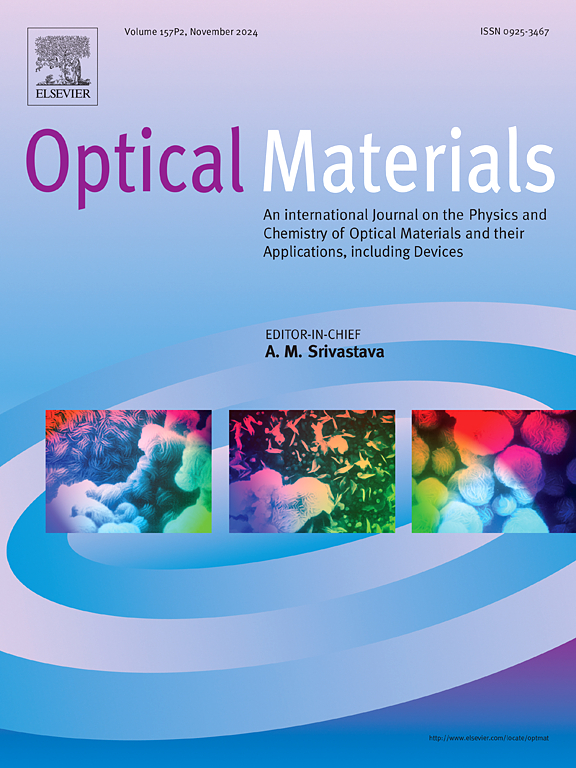闪蒸硫化镉薄膜的结构、形态和光学特性研究
IF 3.8
3区 材料科学
Q2 MATERIALS SCIENCE, MULTIDISCIPLINARY
引用次数: 0
摘要
在真空条件下采用闪蒸法成功合成了硫化镉薄膜,然后在不同温度下进行了退火处理。X 射线衍射图样显示形成了六方沃特兹相。这种最稳定相的结构特性在所有研究温度下都大致相同。扫描电子显微镜显示形成了颗粒状薄膜。能量色散 X 射线光谱显示可能形成了共价化合物。获得的紫外可见光谱显示,制备的薄膜具有适度的直接带隙,在可见光范围内具有较高的透射率。对结构、光学和光电研究结果的详细解读表明,退火的 CdS 薄膜具有制造下一代现代光电设备的巨大潜力。研究人员在真空条件下采用闪蒸法成功合成了硫化镉薄膜,并在不同温度下进行了退火处理。X 射线衍射图样显示,在所有温度下都形成了结构特性几乎相同的六方闪锌矿相。紫外-可见光谱显示,所制备的薄膜具有适度的直接带隙,在可见光范围内具有较高的透射率,这增强了这些薄膜在光伏和光触媒应用方面的实用性。扫描电子显微镜显示形成了颗粒状薄膜,而能量色散 X 射线光谱显示可能形成了共价化合物。本文章由计算机程序翻译,如有差异,请以英文原文为准。
Study of structural, morphological and optical properties of flash evaporated cadmium sulphide thin films
Cadmium sulphide thin films were successfully synthesized by the flash evaporation method under vacuum, then annealed at various temperatures. X-Ray Diffraction patterns showed the formation of the hexagonal wurtzite phase. Structural properties of this most stable phase remain approximately the same at all investigated temperatures. Scanning Electronic Microscopy showed the formation of granular films. The Energy Dispersive X-ray spectra revealed the possible formation of stoichiometric compounds. The obtained UV–Vis spectra revealed that the prepared films exhibit a moderate direct band gap with high transmittance in the visible range. Detailed interpretation of the structural, optical, and optoelectronic findings revealed that annealed CdS thin films hold promising potential for the fabrication of the next generation of the modern optoelectronic devices. Cadmium sulphide thin films were successfully synthesized by the flash evaporation method under vacuum, then annealed at various temperatures. X-Ray Diffraction patterns showed the formation of the hexagonal wurtzite phase for all temperatures with almost the same structural properties. UV–vis spectra revealed that the prepared films exhibit a moderate direct band gap with high transmittance in the visible range, which reinforces the usefulness of these films for photovoltaic and photocatalytique applications. Scanning Electronic Microscopy shows the formation of granular films, while the Energy Dispersive X-ray spectra revealed the possible formation of stoichiometric compounds.
求助全文
通过发布文献求助,成功后即可免费获取论文全文。
去求助
来源期刊

Optical Materials
工程技术-材料科学:综合
CiteScore
6.60
自引率
12.80%
发文量
1265
审稿时长
38 days
期刊介绍:
Optical Materials has an open access mirror journal Optical Materials: X, sharing the same aims and scope, editorial team, submission system and rigorous peer review.
The purpose of Optical Materials is to provide a means of communication and technology transfer between researchers who are interested in materials for potential device applications. The journal publishes original papers and review articles on the design, synthesis, characterisation and applications of optical materials.
OPTICAL MATERIALS focuses on:
• Optical Properties of Material Systems;
• The Materials Aspects of Optical Phenomena;
• The Materials Aspects of Devices and Applications.
Authors can submit separate research elements describing their data to Data in Brief and methods to Methods X.
 求助内容:
求助内容: 应助结果提醒方式:
应助结果提醒方式:


